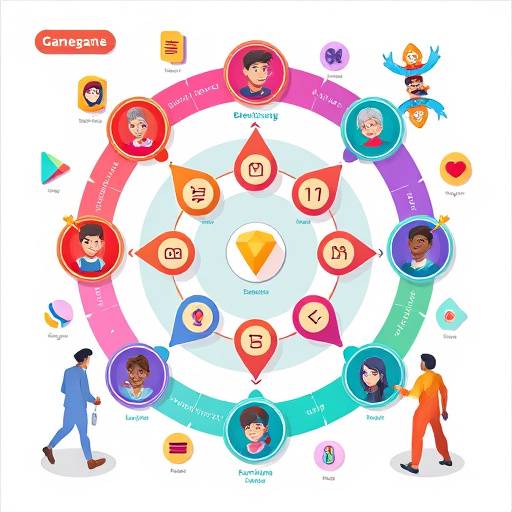The New Frontier: Where Attention is the Ultimate Currency
In the rapidly evolving digital cosmos, the gaming industry has ascended as a colossal entity within the attention economy. This realm, distinct from traditional economies reliant on tangible assets or financial capital, flourishes on the perpetually scarce resource of human focus. Every fleeting second a player dedicates to navigating a virtual landscape, mastering intricate mechanics, or participating in communal interactions represents a precious unit of attention being actively exchanged. This fundamental dynamic has irrevocably reshaped the architecture of game design, marketing paradigms, and monetization frameworks, giving rise to sophisticated ecosystems meticulously crafted to capture and sustain player engagement. A deep comprehension of these underlying mechanisms is not merely beneficial but essential for game creators, industry stakeholders, and even discerning players, offering invaluable insights into the subtle yet potent forces that sculpt our digital interactions. The siren call of digital worlds, the electrifying pulse of competition, and the profound satisfaction derived from achievement coalesce to form an irresistible magnetic force, effectively transforming passive observation into dynamic, immersive participation. This seismic shift from a product-centric valuation to an attention-centric value creation is far more than a transient trend; it signifies a fundamental redefinition of digital engagement itself.

The underlying principle is elegantly straightforward: the more profound and sustained the attention a game can command, the greater the multitude of opportunities it unlocks for revenue generation, the cultivation of a vibrant community, and the establishment of an enduring digital legacy. This relentless pursuit of player attention has catalyzed remarkable innovations in game design, manifesting as intricate reward pathways, captivating narrative arcs, and seamless social integration. However, this drive also precipitates critical dialogues concerning player welfare, the ethical underpinnings of game development practices, and the long-term viability of engagement-centric business models. As games progressively delve into greater complexity and immersive realism, the strategies employed to secure and retain player attention become increasingly refined, drawing liberally from the established principles of behavioral psychology, cutting-edge neuroscience, and sophisticated data analytics. The industry finds itself in a perpetual state of dynamic evolution, with visionary developers and designers relentlessly striving to conceive experiences that transcend mere entertainment, aiming instead for profound engagement, thereby nurturing a devoted player base that consistently returns, eager for more.
Key Drivers of Attention in Gaming: The Mechanics of Engagement
Compelling Gameplay Loops
At the very core of any successful gaming endeavor lies the robust framework of its gameplay loop. This concept refers to the cyclical sequence of player actions and their subsequent rewards, meticulously designed to foster a continuous desire for return play. Whether it manifests as the classic 'quest-loot-upgrade' paradigm prevalent in role-playing games, the 'play-win-earn' cycle central to competitive multiplayer arenas, or the 'explore-discover-build' progression found in expansive sandbox environments, these loops are engineered with the specific intent of delivering consistent positive reinforcement and a palpable sense of forward momentum. Each action executed within this loop is crafted to be intrinsically gratifying or to pave the way for a future, anticipated reward, thereby minimizing any potential friction points and maximizing the player's investment of both time and effort. The psychological underpinnings of variable-ratio reinforcement schedules, strikingly akin to the mechanisms employed in slot machines, are frequently harnessed to sustain elevated levels of player engagement. The sheer anticipation of the next forthcoming reward, the exhilarating thrill of a rare item acquisition, or the deep-seated satisfaction of overcoming a formidable challenge collectively fuels the impulse for continued gameplay, creating an eager desire within players to repeatedly traverse the cycle.
Narrative Immersion and Storytelling
Beyond the fundamental mechanics, the power of profoundly compelling narratives serves as a formidable anchor for player attention. Narratives that are expertly crafted, replete with rich lore and relatable characters, possess the unique ability to draw players deep into a game's meticulously constructed world, fostering a genuine emotional investment in the unfolding events and the ultimate outcomes. Interactive storytelling, a format where player choices directly influence the narrative's trajectory, serves to further amplify this sense of immersion. The emotional resonance forged through skillful storytelling becomes a potent impetus for continued play, extending beyond the mere pursuit of in-game progression to a deeper yearning to witness the unfolding story. Games have, over time, transformed into sophisticated mediums for storytelling, capable of delivering narratives of such complexity and depth that they readily rival those presented in film or literature. The capacity for players to actively shape and influence the narrative through their direct participation cultivates a profound sense of shared ownership and unwavering commitment to the experience. This immersive storytelling is an indispensable tool in the arsenal for retaining player attention, elevating a simple pastime into a genuinely meaningful and memorable journey.
Social Connection and Competition
Human beings are intrinsically social organisms, and the world of gaming effectively capitalizes on this innate characteristic by actively fostering vibrant communities, facilitating collaborative endeavors, and igniting the flames of competition. Multiplayer modes, guild systems, strategic alliances, and shared interactive experiences collectively forge a powerful sense of belonging and purpose, significantly increasing the likelihood of players dedicating their valuable time to the game. The innate desire to connect with friends, collaboratively overcome formidable challenges, or triumph over rivals constitutes a significant driving force behind sustained player engagement. Social features, ranging from rudimentary chat functionalities to the intricate complexities of guild raids and highly competitive player-versus-player arenas, are fundamental to maintaining player interest and retention. The constant, dynamic presence of other players, the shared pursuit of collective goals, and the myriad opportunities for both cooperative efforts and spirited rivalry create an inherently engaging environment that commands sustained attention. This robust social fabric ensures that players are not merely engaging with a game in isolation, but are integral participants in a dynamic, living community, which demonstrably enhances retention rates and extends overall playtime.
Psychological Triggers and Reward Systems
Game designers have honed their skills to a remarkable degree in employing sophisticated psychological principles to amplify player engagement. This encompasses the strategic utilization of concepts such as variable reward schedules, the exploitation of scarcity, effective goal-setting frameworks, and the subtle manipulation of progress indicators. The sheer exhilaration of a rare item drop, the palpable anticipation surrounding a limited-time in-game event, or the visual affirmation of a meticulously designed progress bar filling to its completion are all carefully engineered elements intended to ensnare players. These carefully deployed triggers forge a potent feedback loop that actively stimulates the brain's reward centers, rendering the act of playing inherently pleasurable, often to the point of being addictive. A nuanced understanding of these triggers empowers developers to optimize player retention strategies and maximize the duration of time players spend immersed within the game's digital confines. From the enticing allure of daily login bonuses to the pervasive influence of achievement systems, every design element is purposefully intended to gently nudge players towards continued interaction, reinforcing desired behaviors and cultivating a pervasive sense of accomplishment that becomes increasingly difficult to disengage from. This intricate, calculated interplay with player psychology stands as a fundamental pillar of contemporary game design.

The Dual Impact: Reshaping Industry and Player Experiences
The unyielding pursuit of player attention casts a long and significant shadow, casting profound implications that ripple through both the gaming industry and the lives of its players. For developers and publishers, this translates into a strategic pivot towards the 'live-service' model, necessitating a continuous influx of updated content and the deployment of data-driven design strategies aimed at indefinitely retaining player interest. Monetization strategies, encompassing in-game purchases, subscription models, and the ubiquitous battle pass system, are intrinsically interwoven with the volume of attention a game can successfully command. While this can foster remarkably profitable business ventures, it simultaneously imposes considerable pressure on developers to conceive experiences that are perpetually engaging, occasionally at the potential detriment of player well-being. For players, the pervasive attention economy offers unparalleled access to an seemingly inexhaustible stream of highly engaging digital content. However, this abundance also carries inherent risks. The ceaseless demand for attention can inadvertently lead to excessive playtime, digital burnout, and the potential for compulsive behaviors if not managed with deliberate responsibility. Developers bear a significant ethical mandate to design games that are not only captivating but also conducive to player health, thereby fostering a balanced and sustainable approach to digital entertainment. The demarcation line between healthy engagement and outright exploitation can indeed be exceedingly fine, and the industry remains in a constant state of grappling with how to navigate this complex and sensitive terrain with integrity, ensuring that player enjoyment and overall well-being remain paramount considerations, alongside critical commercial objectives. The success of games hinges on creating environments that are both captivating and responsible.
In the intricate dynamics of the attention economy, modern games transcend their status as mere products; they are meticulously crafted experiences designed with the explicit purpose of consuming time, fostering robust community bonds, and cultivating sustained, ongoing engagement from their player base.
The future trajectory of the gaming industry is indelibly linked to its inherent capacity to adeptly manage and strategically leverage player attention. As novel technologies emerge and player expectations continue to evolve at an unprecedented pace, the methodologies and strategies employed within this domain will undoubtedly adapt and transform. The overarching challenge lies in achieving a delicate equilibrium between ensuring commercial viability and upholding stringent ethical considerations, thereby guaranteeing that the relentless pursuit of player attention serves to enrich, rather than exploit, the player's experience. This continuous process of adaptation necessitates a critical, insightful understanding of the underlying forces at play, an unwavering commitment to player-centric design philosophies, and a palpable willingness to embrace change within a rapidly transforming digital landscape. The games destined for enduring success will invariably be those that offer genuine, quantifiable value, cultivate meaningful and lasting connections among players, and demonstrate a profound respect for the invaluable and precious resource of player attention. This holistic approach ensures a sustainable and ethical future for gaming.